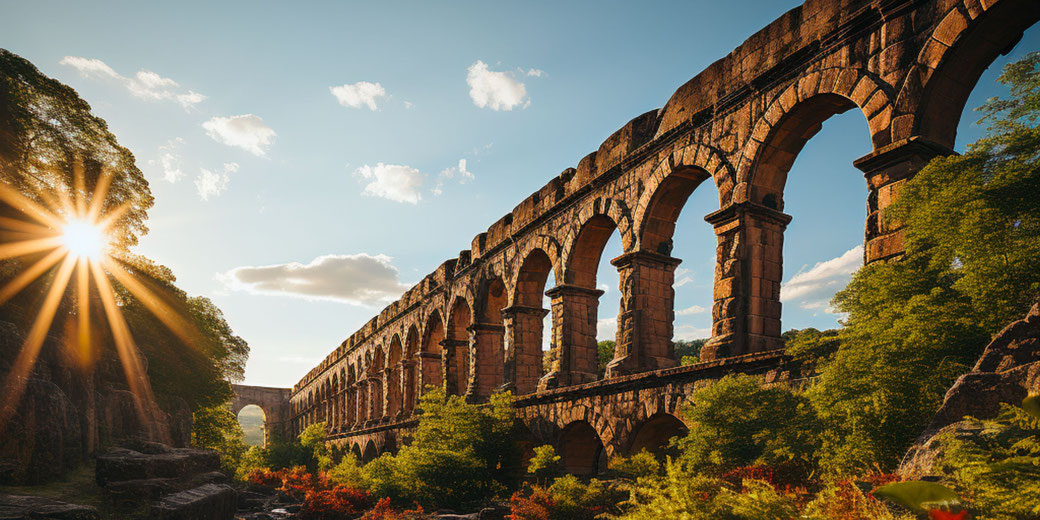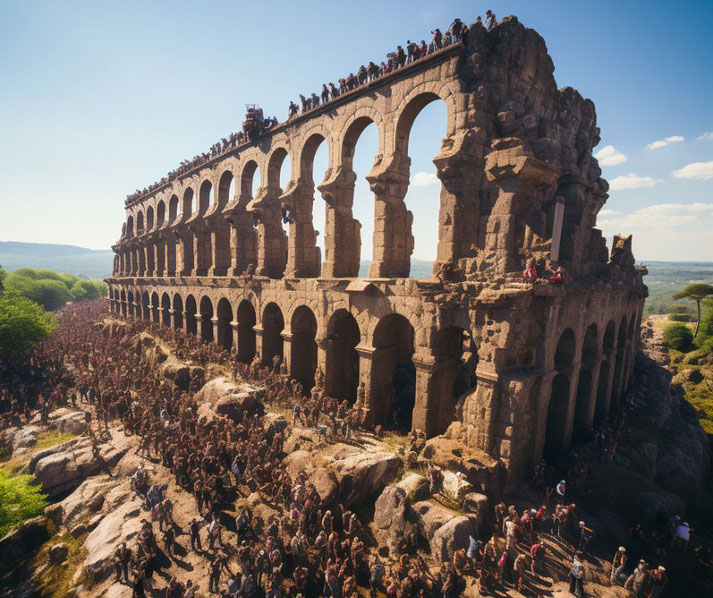The aqueducts of Rome: The engineering secrets behind the empire's water supply

Snaking its way between modern buildings and bustling streets, lies the timeless skeleton of an ancient aqueduct—mute testimony to the astonishing engineering feats of a civilization that laid the foundation for much of the Western world.
While the Colosseum, Roman Forum, and the Pantheon often monopolize attention, Roman aqueducts are, in many ways, the unsung heroes of ancient innovation.
These remarkable systems not only symbolize the ingenuity of Roman engineering but also offer a lens through which to view the socio-political intricacies of an empire that once stretched from the British Isles to the Arabian Peninsula.
The origins of the first Roman aqueducts
Long before the Roman Empire reached its zenith, the people of the Italian peninsula were already wrestling with a critical question: how to secure a stable supply of fresh water for their burgeoning settlements.
The seven hills upon which Rome was founded presented a particularly intriguing challenge.
While the River Tiber offered a convenient waterway for commerce and travel, it wasn't ideally suited for drinking water due to pollution and the natural sediment carried by the river.
The early Romans, therefore, turned their attention to springs and streams further afield, laying the groundwork for what would eventually become one of the most advanced water management systems in the ancient world.
It was in 312 BCE that Rome took its first monumental step in addressing its water needs with the construction of the Aqua Appia.
Commissioned by Appius Claudius Caecus, this aqueduct spanned over 16 kilometers, marking the city’s first foray into organized water transport.
The Aqua Appia was not just an engineering project; it was also a bold statement about Rome’s growing ambitions.
As much as it was about moving water, it was also about moving Rome into a new era—an era of urban planning, public works, and a centralized approach to resources.
Importantly, it set a precedent for the many more ambitious aqueduct projects that would follow.
With the success of the Aqua Appia, Roman engineers and policymakers grew more confident.
Aqua Marcia, built between 144 and 140 BCE, was an even more ambitious project that brought water from springs about 91 kilometers away.
It introduced new technologies such as the use of concrete-lined tunnels and pressurized siphons to cross valleys.
The Aqua Marcia became synonymous with the luxury of having pure, cold drinking water, and its completion was a watershed moment, not only in terms of engineering but also in setting the standard for public amenities.
The aqueducts that followed, like the Aqua Tepula and Aqua Julia, borrowed from these earlier innovations, each iteration pushing the boundaries of what Roman engineering could achieve.
Why the aqueducts were so remarkable
Roman aqueducts were nothing short of revolutionary. The most immediately recognizable feature of these marvels was perhaps their arches, a series of stoic stone curves that have stood the test of time.
But the structural beauty that captures our imagination today is only the tip of the engineering iceberg.
Underneath these arches lay a myriad of other ingenious solutions, from the materials used in construction to the principles of fluid dynamics that governed the flow of water.
The Romans embraced a holistic approach to their aqueduct systems, combining disparate elements into a cohesive, functional whole.
One of the pivotal materials in aqueduct construction was "Opus Caementicium," a form of Roman concrete.
Unlike the simple mud bricks of earlier constructions, this concrete mixture had the durability to withstand both the weight of flowing water and the erosive forces of time.
It was an ideal material for lining underground tunnels, making the aqueducts more resistant to leaks and contamination.
The introduction of this concrete not only revolutionized Roman building practices but also set the stage for larger and more complex aqueduct systems.
Advancements in material science were accompanied by an evolving understanding of fluid dynamics.
Engineers employed gravity to its maximum potential, maintaining a slight downward gradient along the aqueduct's course to keep water flowing steadily.
When natural obstacles like valleys or rivers stood in the way, the Romans demonstrated yet another technological marvel: the siphon.
Through the principle of atmospheric pressure, inverted siphons allowed water to flow uphill temporarily, surmounting geographical obstacles that would have stymied less advanced societies.
And when it came to distributing this water, Roman engineers used a distribution tank called a "castellum divisorium," a marvel of both engineering and fair division, ensuring that different parts of the city received an equitable share of the vital resource.

The most famous of all Rome's aqueducts
Among the vast network of Roman aqueducts, certain iconic systems stand out, each a marvel in its own right that demonstrates the range, adaptability, and ingenuity of Roman engineering.
The Aqua Marcia, completed in 144 BCE and stretching over 91 kilometers, was famed for providing the highest-quality drinking water to the city of Rome.
Its lengthy channel incorporated a mix of tunnels, surface channels, and elevated arches, a showcase of the diverse engineering solutions the Romans had perfected over time.
Its completion marked a significant point in Roman history, heralding a new era where public amenities were not just functional but also luxurious.
While the Aqua Marcia catered to the tastes of Rome, the Pont du Gard in southern France was built primarily to serve the city of Nîmes.
This massive stone aqueduct bridge is often cited as one of the best-preserved Roman aqueducts.
Spanning the Gardon River, the Pont du Gard is not just a functional watercourse but also a work of art, its tiers of stone arches rising majestically above the water below.
It underscores the Romans' ability to adapt their engineering expertise to different terrains and conditions, illustrating that the technological marvels of Rome were not confined to the city itself but were a cornerstone of the broader Roman world.
Then there is the Aqua Virgo, an aqueduct with both historical significance and modern relevance.
Built in 19 BCE by Marcus Agrippa, it was designed to bring water to Rome's new public baths.
Remarkably, the Aqua Virgo remains one of the few Roman aqueducts still functioning, and its water still feeds the famous Trevi Fountain.
It serves as a living link to Rome's ancient past, proving the enduring efficiency of Roman engineering.
Like the Aqua Marcia, it too was a technological marvel but gains added significance from its continual operation through two millennia, serving generations long after the fall of the Roman Empire.
Another noteworthy aqueduct is the Aqua Traiana, commissioned by Emperor Trajan in the early 2nd century CE.
This aqueduct was sourced from Lake Bracciano, about 40 kilometers northwest of Rome.
What sets it apart is the innovative filtration system that was integrated into its design, ensuring that the water reaching Rome was of the highest quality.
This was a step forward in public health, a feature that mirrored the empire's growing sophistication not just in engineering but in the overall welfare of its citizens.
How the Romans ensured the waters kept flowing
Building and maintaining such an extensive network required not just masons, architects, and laborers but also a complex hierarchy of administrators who oversaw the aqueducts' operation from source to spout.
At the helm were government officials specifically appointed to oversee water supply and sanitation.
These roles were not merely functional; they were prestigious positions, a testament to the importance Roman society placed on the management of its most crucial resource—water.
A landmark moment in the governance of Roman aqueducts came with the appointment of Sextus Julius Frontinus as Water Commissioner in 97 CE.
Frontinus, whose meticulous work is immortalized in the treatise "De Aquis Urbis Romae," or "On the Water Supply of Rome," standardized much of the Roman approach to water management.
His writings offer an invaluable look into the administrative machinations that enabled the smooth functioning of these infrastructures.
Frontinus delved into the details of water flow rates, legal regulations, and even the problems of water theft and fraud, thereby providing a template for a highly organized, regulated system.
His treatise demonstrates that the aqueducts were not just feats of engineering but also represented a triumph of administrative oversight.
Of course, administration went hand in hand with fiscal management. The construction and maintenance of aqueducts required substantial financial investment.
Funding came from various sources, including state coffers and generous patrons, often emperors who saw the political and social benefits of contributing to public infrastructure.
In some instances, such as that of the Aqua Claudia, construction was initiated by one emperor and completed by another, underscoring the scale of these projects and the need for sustained investment and administrative continuity.
It was an intricate financial balancing act, ensuring that this public good could be delivered efficiently and equitably, and required meticulous planning and execution.
Governance also reached down to the level of ordinary citizens. To enforce water regulations and ensure equitable distribution, inspectors and minor officials were tasked with monitoring usage, maintaining flow rates, and reporting back to their superiors.
Their roles were crucial in a system where the equitable distribution of water was a matter of public welfare and even social justice.
Even slaves played a role in this intricate administrative puzzle, often being assigned to perform the menial but vital tasks necessary to keep these complex systems running smoothly.

What remains of the aqueducts
While the Roman Empire itself is gone, its ingenuity, particularly in the form of its famed aqueducts, survives.
These ancient infrastructures stand as enduring legacies of Rome's innovative spirit and its commitment to enhancing the quality of life for its citizens.
Today, the remnants of Roman aqueducts can be found scattered across the geographical span of the former empire, from Italy and Spain to North Africa and the Middle East.
And it's not just their physical remains that fascinate us; it is the ingenuity they embody, the vision they represent, and the vivid illustration they provide of ancient Rome's daily life and governance.
Various preservation efforts have been undertaken to maintain these historical structures for future generations.
Take, for instance, the Pont du Gard in France, a UNESCO World Heritage site, which is one of the most visited ancient monuments in the country.
It has been meticulously restored and preserved, providing millions with the opportunity to glimpse the extraordinary technological capabilities of the Roman Empire.
The Aqua Virgo, too, continues to serve modern Rome, its waters flowing through the iconic Trevi Fountain, effectively turning an ancient marvel into a functioning part of a bustling contemporary city.
What do you need help with?
Download ready-to-use digital learning resources
Copyright © History Skills 2014-2024.
Contact via email
With the exception of links to external sites, some historical sources and extracts from specific publications, all content on this website is copyrighted by History Skills. This content may not be copied, republished or redistributed without written permission from the website creator. Please use the Contact page to obtain relevant permission.





